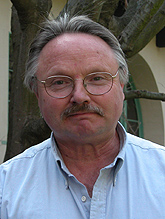Berkeleyan
Science with a point of view![]()
| 31 March 2005
 George Brimhall (Wendy Edelstein photo) |
This semester, Brimhall, a resource geologist, rolled out his new American
Cultures course, Crossroads of Earth Resources and Society (EPS 106AC,
cross-listed as L&S 107AC), a historical examination of how European
Americans, indigenous peoples, and Asian Americans interacted while seeking
their place on the land and striving for human rights. His objective is
not simply to provide students with a historical framework but to help
them see how their ancestors were part of the nation’s social fabric
and that “the resources we use every day are part of the Earth.
The greatest challenge in regard to the American consumer lifestyle,” says
Brimhall, “is getting people to see their own personal, everyday
role in this issue.”
Brimhall covers a lot of figurative ground in the course, beginning with
the current situation in Iraq, “to show how resources influence
foreign policy.” After Saudi Arabia, Iraq has the second-largest
oil reserves in the world, notes Brimhall. Part of the purpose of the
class, he says, “is to encourage students to ask questions and search
for truth rather than passively listen to the media.”
From there the syllabus takes an ethnogeographic turn, moving far back
in time to the Pleistocene era when, Brimhall says, the ancestors of the
Native Americans were “far from primitive peoples, surviving the
worst climate variations imaginable, and very sophisticated in their understanding
of nature and its cycles.”
Unlike the old iteration of the class that drew geology students primarily,
the redesigned version has attracted equal numbers of science and non-science
students, says Brimhall, from “an incredible array of majors” — art
history, political science, math, English literature, pre-law. He takes
special pleasure in seeing students from such different areas of interest
interact with each other.
An extended opportunity for students to mix will come later in the semester.
A “real believer in field trips,” Brimhall has arranged a
two-day expedition to the Sierra foothills, incorporating suggestions
from anthropology professor Kent Lightfoot. Mother Lode geology, the Gold
Rush, and Victorian-era architecture will be mixed in with a discussion
of the Miwok tribe that once lived in the path of the Gold Rush. Students
will record their impressions in journals that they’ll share around
the evening campfire in the Miwok village not far from their campsite.
One measure of the course’s success, says Brimhall, will be if students assume “a sense of ownership” of these “very real issues of sustainability. We’re the greatest consumer society in the world,” he observes, “and we have no idea how much stuff we use.”

